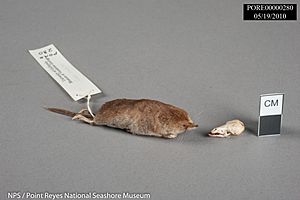Suisun shrew facts for kids
Quick facts for kids Sorex ornatus sinuosus |
|
|---|---|
 |
|
| A Sorex ornatus sinuosus specimen | |
| Scientific classification |
|
| Kingdom: | Animalia |
| Phylum: | Chordata |
| Class: | Mammalia |
| Order: | Eulipotyphla |
| Family: | Soricidae |
| Genus: | Sorex |
| Species: | |
| Subspecies: |
S. o. sinuosus
|
| Trinomial name | |
| Sorex ornatus sinuosus Grinnell, 1913
|
|
The Suisun shrew (scientific name: Sorex ornatus sinuosus) is a special type of subspecies of the ornate shrew. It lives in the wet, muddy areas called marshes near the northern parts of San Pablo and Suisun bays. These bays are northern arms of the San Francisco Bay in California.
You can find the Suisun shrew as far east as Grizzly Island and as far west as the mouth of Sonoma Creek. This includes areas around Tubbs Island. The U.S. government and the state of California consider the Suisun shrew a "Species of Concern." This means they are worried about its survival and want to protect it.
Contents
What Does the Suisun Shrew Look Like?
The Suisun shrew is a small and somewhat rare animal. It is a type of shrew known as a soricine shrew. You can tell it apart from other shrews in the area because it has darker fur. It also lives only in the tidal marshes near San Pablo and Suisun bays.
These shrews usually weigh between 4.5 and 6.8 grams, which is about the weight of a few paper clips. Their total length, including their tail, is about 98 to 106 millimeters (about 4 inches). The tail itself is 35 to 44 millimeters long. Their fur is usually black, sometimes with a shiny, metallic look. The Suisun shrew also has a long, narrow, and delicate skull.
Where Does the Suisun Shrew Live?
The Suisun shrew lives in tidal marshes. These are wetlands that are regularly flooded by ocean tides. The types of plants found there depend on how much water they can handle.
Some common plants in their habitat include California cordgrass, glasswort (Salicornia ambigua), and hairy gumweed (Grindelia cuneifolia). They also live in marshes with slightly salty water, where you might find California bulrush (Scirpus californicus) and common cattail (Typha latifolia).
This little animal needs thick, low-lying plant cover. This cover helps them hide and find lots of small invertebrates to eat. The way the plants grow, rather than how many different types of plants there are, is most important for shrews. They also need Driftwood and other natural debris above the high-tide line for building nests and finding food.
Areas of higher land next to the marshes are also very important. These upland habitats give shrews a safe place to go during long floods.
Changes to Their Home
In the mid-1800s, the San Pablo and Suisun bays were surrounded by large marshes. However, by 1990, these wetlands had shrunk into smaller, separate areas. The marshes in Suisun Bay, especially the Napa Sonoma Marsh, are the largest remaining ones.
However, the Suisun shrew populations there are at risk. This is due to human expansion and how some marshes are managed. Very few tidal marshes today have their original, untouched plants. Even fewer have large upland areas nearby where marsh animals can escape floods. The Suisun shrew lives in a smaller area and uses fewer types of habitats than other animals, like the salt marsh harvest mouse.
Life Cycle and Behavior
Most shrews live for about 16 months. Female shrews often live a little longer than males. The Suisun shrew mainly eats small insects and other invertebrates.
Reproduction
Suisun shrews usually have their babies during the spring and summer. The mother is pregnant for about 21 days. A litter can have anywhere from two to nine babies. While a female can have two litters in a year, one is more common. The babies are born helpless (called altricial) and depend on their mother for another 21 days before they are weaned. Some young shrews, less than a year old, might also breed in late summer.
Surviving Winter
During winter, most shrews lose a lot of body weight. Shrews that are in their second year of life often die during this time. This winter weight loss is called the Dehnel phenomenon. It's a way for them to survive winter when there is less food. Their body weight can drop to 70% of their weight from the previous summer. Their body length also shrinks because the discs in their spine get smaller. Even their skull, kidneys, and some other internal organs get smaller. This means they need less food to stay alive.
In the spring, shrews gain weight again. They usually reach a slightly higher weight than they were the previous summer. Many adult male shrews then move into the population areas. The area where the shrews live can even double in size. This can disrupt their usual winter territories, sometimes leading to fights between shrews.
Breeding starts again from April through October. They often breed in dense groups within a small area of their favorite habitat. Young females often stay close to where they were born. Young males, however, often move away, possibly because of older, dominant males. These young males usually stay near their original group, but in less ideal habitats.
Protecting the Suisun Shrew
The Suisun shrew is a rare species that is protected by the U.S. federal government and the state of California. Besides being a "Species of Special Concern," California has passed the Suisun Marsh Preservation Act. This law helps protect the habitat of the Suisun shrew. It also protects other sensitive species like the California clapper rail and the salt marsh harvest mouse. Many efforts to protect marshes help a variety of animals, both those that are endangered and those that are more common.

